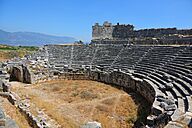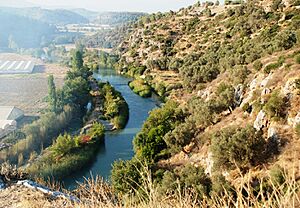Xanthos facts for kids
|
Ksantos
|
|
|
|
|
| Location | Kınık, Antalya Province, Turkey |
|---|---|
| Region | Lycia |
| Coordinates | 36°21′22″N 29°19′7″E / 36.35611°N 29.31861°E |
| Type | Settlement |
| Area | 126 ha (310 acres) |
| Site notes | |
| Website | turkishmuseums.com |
| Official name | Xanthos-Letoon |
| Designated | 1988 (12th session) |
| Reference no. | 484 |
| Europe and North America | |
Xanthos (also called Xanthus) was an important ancient city in Lycia, a region in what is now Turkey. Its Lycian name was Arñna. The city ruins are found on a hill next to the Xanthos River, near the modern village of Kınık.
Xanthos is famous for its many ancient tombs that are still standing. Because of these special tombs and its close connection to the nearby religious site of Letoon, Xanthos became a UNESCO World Heritage Site in 1988.
This city was a major center for the Lycian people. Later, it was ruled by the Persians, Greeks, and Romans. Xanthos was so important that its buildings, like the Nereid Monument, even inspired other famous structures, such as the Mausoleum at Halicarnassus.
Contents
History of Xanthos
The oldest parts of Xanthos, like its acropolis (a fortified high part of the city), date back to the 8th century BCE. Ancient Greek and Roman writers often mentioned Xanthos. The Greek historian Strabo said it was the biggest city in Lycia. The important religious place of Leto at Letoon, just 4 kilometers south, was built in the late 6th century BC. It was strongly connected to Xanthos by a special road.
Under the Persian Empire
Greek historians Herodotus and Appian wrote about the Persian Empire taking over Xanthos. Around 540 BC, the Persian general Harpagus defeated a small Lycian army outside the city. The Lycians then went back into Xanthos.
Harpagus started to attack the city. The Lycians chose to destroy their own acropolis and then fought the enemy in a very brave, but hopeless, battle. This showed their strong spirit and refusal to surrender.
During the time the Persians ruled, local leaders were put in charge. By 520 BC, Xanthos was making its own coins. It was also listed as a city that had to pay taxes to the Persian king Darius I.
Conquest by Alexander the Great
Alexander the Great and his army marched to Xanthos from Telmessos. Representatives from all the cities in the Lycian League, including the port of Phaselis, came to Xanthos to surrender peacefully to Alexander. He accepted their surrender.
Alexander was encouraged when he found a sacred spring near the Xanthos River. From this spring, he got a bronze tablet with writing on it. This tablet predicted that the Greeks would defeat the Persian Empire.
There are different stories about how Xanthos surrendered to Alexander. Some say it was peaceful, while others claim the city was attacked and damaged. After Alexander's death, Xanthos was taken by Ptolemy I Soter from another general named Antigonos.
Roman Period
Xanthos became part of the Roman province of Lycia. In 42 BC, during the Roman Civil Wars, a Roman leader named Brutus came to Lycia. He wanted money for his military campaign. The Lycian League refused to help him.
Brutus then attacked Xanthos. The city was once again destroyed, and only about 150 men from Xanthos survived. However, some historians say that the people of Xanthos set their own city on fire, just like they did when the Persians attacked. Brutus and his soldiers tried to save the city from the flames but could not.
The city was rebuilt later under another Roman leader, Mark Antony. Most of the buildings you can see today were built during the later Roman Empire. The town was planned with a grid of streets. A large public square with covered walkways was built in the west, likely where the old market used to be. There was also a big building that might have been a public hall or a church.
Byzantine Period
Like other parts of Lycia, Xanthos did well during the later Roman period. Fancy houses were built on the Lycian acropolis. Several churches were also built, including a very large one. In the sixth century, earthquakes damaged many buildings, but they were repaired. The city walls were also made stronger because of threats from Arab armies. Eventually, the city was destroyed and left empty.
Archaeology at Xanthos

Archaeological digs at Xanthos show that wooden buildings were destroyed around 470 BC. This was probably done by the Athenian general Kimon. After this, Xanthos was rebuilt using stone.
Some of the most famous monuments from Xanthos, like the Nereid Monument, the Tomb of Payava, and the original sculptures from the Harpy Tomb, are now displayed in the British Museum in London. The Harpy Tomb itself is still in Xanthos, but it now has copies of the sculptures.
During the archaeological work, many writings have been found in both the Lycian language and Greek. These bilingual (two-language) texts are very helpful for understanding the Lycian language. The Xanthian Obelisk, also called the Inscribed Pillar, is a stone monument found in the city. It has writing in three languages, including an older language called Milyan.
Location of Xanthos
Xanthos is located very close to the modern village of Kınık in Turkey.
World Heritage Site
Xanthos was added to the UNESCO World Heritage Site list in 1988. It shares this honor with the nearby ancient site of Letoon.
Related articles
- Hermogenes of Xanthos






